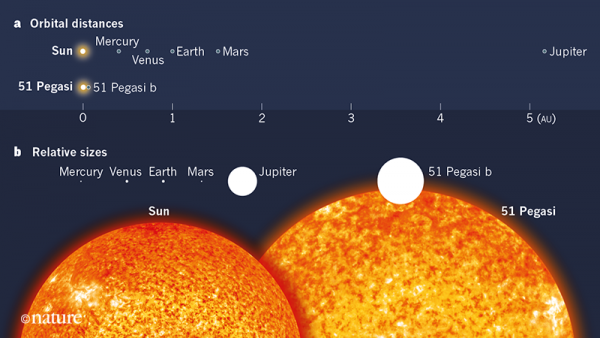Anyone over the age of 35 will remember growing up in a world in which only one planetary system was known — our own. We remember proudly reciting the names of the nine planets (eight before Pluto’s discovery in 1930, and again today with its reclassification as a dwarf planet in 2006) and wondering what other planets might exist around the stars in the night sky. Contemplating life beyond the Solar System was relegated to science fiction. This all changed in 1995 when Mayor and Queloz1 reported the detection of the first exoplanet around a Sun-like star.
The discovery of the gas-giant planet — named 51 Pegasi b after its parent star, 51 Pegasi — came as a surprise. Gas-giant planets, such as Jupiter, are located in the outer parts of the Solar System. The prevailing theory was, and still is, that the formation of these planets requires icy building blocks that are available only in cold regions far away from stars. Yet Mayor and Queloz found 51 Pegasi b to be orbiting about ten times closer to its host star than Mercury is to the Sun (Fig. 1). One possible explanation is that the planet formed farther out and then migrated to its current location.
The gas-giant planet was not the first exoplanet to be discovered. However, the previous detections2,3 were of even stranger objects orbiting pulsars — rapidly spinning neutron stars, which are the collapsed remnants of hot massive stars. The discovery of 51 Pegasi b was the first to substantiate the existence of planets around long-lived hydrogen-burning stars that resemble the Sun.
The bizarre character of a gas-giant planet orbiting so close to its parent star engendered considerable scepticism about the true nature of 51 Pegasi b. Mayor and Queloz detected the planet through minute back-and-forth motion of 51 Pegasi, which seemed to indicate that a planet-mass object was pulling on the star. But this stellar motion, sensed by frequency shifts in the spectra of light from 51 Pegasi, had other possible interpretations. A lively debate ensued in the literature about whether pulsations of the star might be masquerading as a planetary signature4,5.
This debate was put to rest in 1998 when the astronomer David F. Gray wrote a paper refuting his previous assertion that the stellar spectra were indicative of pulsations rather than a planet6. Further vindication came through the detection of planets similar to 51 Pegasi b, as other researchers combed their existing data for similarly unexpected planetary signals7. These highly irradiated giant planets have come to be known as hot Jupiters.
In the 24 years since the discovery of 51 Pegasi b, about 4,000 exoplanets have been identified (see go.nature.com/2jpcgtf). Other detection techniques have entered the scene, including the transit method, in which an exoplanet is revealed through the subtle dimming of its host star as the planet crosses the line of sight between Earth and the star. Hot Jupiters have continued to be discovered by the many exoplanet searches that are sensitive to large planets on close orbits. However, it is now known that such objects are intrinsically rare, orbiting only about 1% of Sun-like stars8.
By contrast, planets known as super-Earths and mini-Neptunes abound. Such objects, which inhabit the size and mass gap between the rocky and gas-giant planets of the Solar System, were also a surprise to planet hunters, but seem to be commonplace in our Galaxy. There is now good reason to think that the Milky Way contains more planets than it does stars9.
Mayor and Queloz’s detection of 51 Pegasi b gave rise to a new field of astronomy. The ranks of exoplanet researchers have been steadily growing, by some counts now making up about one-quarter of the astronomy profession (see go.nature.com/32imc4j). Incipient subfields include the study of exoplanet demographics and the characterization of exoplanetary atmospheres.
This characterization has confirmed that hot Jupiters truly are gas-giant planets, but ones representing what our own Jupiter would look like if it were suddenly transported 100 times closer to the Sun. Amid the scorching-hot hydrogen–helium envelopes of these planets, astronomers have detected trace amounts of steam, carbon monoxide and metal vapours10–12. Such atmospheric studies could lead to the eventual characterization of exoplanets that resemble Earth.
The future of the exoplanet field is bright. In April 2018, NASA launched the Transiting Exoplanet Survey Satellite (TESS), a space telescope that is just beginning to fulfil its mission of finding small transiting planets around the brightest stars in the night sky. These planets will be ideally suited for follow-up using NASA’s James Webb Space Telescope (JWST), once it launches, to measure their atmospheric properties and compositions. Following on the heels of JWST, the European Space Agency has selected the Atmospheric Remote-sensing Infrared Exoplanet Large-survey (ARIEL) space telescope to launch in 2028. ARIEL will be dedicated to characterizing the atmospheres of a wide sample of exoplanets.
These programmes are paving the way towards the ultimate goal of potentially detecting the signatures of life on an exoplanet. This goal could most optimistically be achievable in the next decade, but more realistically will require a new generation of space- and ground-based telescopes13. What is remarkable is that humans have gone from discovering the first exoplanets to legitimately plotting out the search for life on these worlds in just a quarter of a century.







